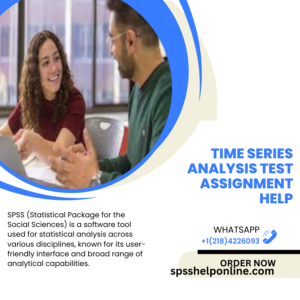Need help with hiring for online SPSS time series analysis test, any advice?
Need help with hiring for online SPSS time series analysis test, any advice? How-to-talk for: your day tutor, in-law, work, business. Sign Up? How-to-talk: Click

Time Series Analysis can help you investigate data collected over an extended period. It allows you to discover trends or patterns which would otherwise remain hidden; and determine whether there have been policy, social, or economic changes which have caused numbers to fluctuate up and down.
Time series analysis is a statistical method designed to identify patterns and trends in data. It utilizes various techniques to deconstruct this information into its component parts such as trend, seasonality and residuals – essential data points when forecasting future trends or for business operations such as tracking daily stock prices or energy consumption rates.
Time series analysis differs from cross-sectional data in that it looks at multiple subjects at one moment in time, whereas cross-sectional analysis involves looking at data at a particular point in time for all. Time series analysis can be applied in many fields such as statistics, econometrics, quantitative finance seismology and meteorology.
Time series data refers to data points collected at regular intervals over time, such as daily or monthly observations of a variable. It’s typically displayed on graphs with one axis representing time while other Axes Represent the variables being measured; usually connected by straight lines for ease of interpretation.
Regression analysis is a statistical method designed to establish relationships among multiple variables. By creating a scatter plot and using mathematical formulae or data science software to calculate its best fit line for data points, regression analysis allows us to predict future outcomes and inform strategic business decisions more precisely.
Regression analysis allows us to predict outcomes more precisely and inform strategic business decisions more confidently. At its core, regression analysis involves creating a scatter plot before creating or using software programs such as SPSS to calculate this line automatically in an instantaneous fashion.
Regression Analysis emphasizes the fact that correlation does not equate to causation. For instance, an increase in sales when it rains could simply reflect increased customer attendance due to rain-driven foot traffic or they discovered something they wanted at that particular store.
Regression models can help you gain insight into relationships that influence business performance and to identify key elements influencing goals and objectives.
Spectral analysis of time series is an indispensable tool in business and research, separating cyclical from trend functions while highlighting random components within time series data. This allows researchers to better study changes within businesses while simultaneously helping businesses prepare for any possible contingencies in advance.
This technique relies on power spectral analysis, which dissects time-domain signals into different frequencies and detects periodicities. A frequency domain representation of any signal can then be used to assess various characteristics like harmonic content, bandwidth usage, modulation spurs and noise; providing vital information necessary to ensuring communications signals can travel long distances without distortion.
Spectral analyses can be carried out with nonparametric and parametric techniques. Nonparametric techniques involve segmenting time Domain Data, applying Fourier transform, and then summarizing or averaging the squared-magnitude of transform. Meanwhile, parametric techniques use models to estimate power spectrum from measured data; both methods offer their own set of advantages and drawbacks.
Time series forecasting involves making scientific predictions based on historical time stamped data and then applying these predictions to strategic decision making in the future. It requires extensive quantitative analysis in order to produce accurate, reliable relationships and patterns that lead to long-term forecasts.
Data must also be collected at regular intervals to avoid gaps which can mask cycles and seasonal variation or conceal outliers, distorting results.
Time series analysis allows businesses to use historical sales information as the basis of sales predictions by tracking units sold over an extended period, then comparing this trend data with current trends. They could also examine sales team performance or call in experts from outside to estimate what will sell best.
Our team of Experts understand the subject matter well and can create an assignment that impresses your professors without compromising quality or missing deadlines. Reach out to us now to discover more!

Statistics assignment help services offer expert guidance and assistance for understanding complex Statistical Concepts. They tailor support specifically to each student’s individual needs, aiding them to gain a deeper insight into this discipline.
Introduce an engaging start with something interesting – like an interesting statistic or surprising piece of data – which will pique readers’ interests and encourage them to continue reading.
Time series analysis is an essential element of data analytics. It helps extract meaningful patterns from temporal data to enable organizations to make sound business decisions. Some key applications of time series analysis include trend detection, anomaly detection, forecasting and optimization.
Time series data points provide a convenient temporal ordering, making them simple to comprehend and analyze. Time series analysis is an invaluable asset for data-driven businesses seeking to optimize operations quickly in response to changing market conditions.
Time series Analysis Models utilize past observations to forecast future ones, taking into account cyclic behavior and seasonality in data variables. Common models for time series analysis include autoregressive integrated moving average (ARIMA), double exponential smoothing and decomposition techniques; these techniques are frequently employed across industries like finance, meteorology and software development.
Descriptive statistics is a type of statistical analysis that uses descriptive metrics to provide an overview and description of data sets. Descriptive statistics serve to reveal information about their distribution and can be displayed graphically or tabulated; additionally they serve as the foundation for more advanced statistical methods.
Descriptive statistics include measures of central tendency (mean, median, mode) as well as measures of dispersion or variability (range, standard deviation, quartiles interquartile range coefficient of variation skewness). These descriptive statistics can be applied to both categorical and quantitative datasets.
Descriptive statistics include baseball player’s batting average or student GPA; however, these don’t reveal causal relationships among larger populations and they have limited comparison capabilities across groups.
Inferential statistics provide inferences about populations by making conclusions based on sample data, employing statistical techniques like hypothesis testing and regression analysis. To conduct inferential statistics effectively, first define your population before randomly sampling from it – this process takes time and requires expertise.
Descriptive statistics help simplify and organize data sets, making them simpler for us to comprehend. They use tools like mean, median, mode and measures of dispersion to describe characteristics within a data set – however they don’t indicate whether those characteristics represent the entire population as a whole.
Inferential statistics use Sample Data to estimate parameters (e.g., population mean) or test hypotheses. Due to being representative samples from populations which contain some variation between themselves and actuality, all samples contain some error – known as sampling error.
Regression analysis is a statistical technique that helps identify relationships among variables. It uses a best-fit line to predict values of dependent variables, and can also assess their effect.
Businesses utilize regression analysis to make more informed decisions based on data. For instance, car manufacturers might utilize regression to forecast future outcomes and understand how price changes impact sales so that they can adjust inventory levels and production accordingly.
However, it’s essential to recognize the limitations of Regression Analysis. For instance, if the independent variables are highly correlated, then results could be inaccurate; additionally outliers may disproportionately alter regression results. To protect yourself against such issues, residual plots should always be checked prior to using regression results.
Factor analysis is an inductive data analytic technique used to combine numerous variables into interpretable latent factors, typically employed in psychometrics and personality psychology research fields as well as businesses looking for an edge by understanding trends or seasonal patterns in their data. Its applications range from psychometrics and personality psychology through various disciplines like economics to forensic science and more.
Step one of factor analysis involves creating a correlation matrix that shows the relationships among variables, using principal component analysis or another method. Next, analysts identify which variables possess strong factor loadings – these will ultimately form part of their final model.
An essential step of Factor Analysis is verifying that your data meets all necessary assumptions for its analysis, including missing values, outliers, normality and linearity. This includes looking out for missing values, outliers and any anomalies which may obstruct its progress.

Time series analysis is a statistical methodology for examining data that has been plotted over a set period. It is used in many fields such as pattern recognition, econometrics, forecasting and weather forecasting.
Time series analysis can be complex and require Specific Skills; tutoring sessions can help students to better comprehend and master this topic.
Time series analysis is an invaluable method for forecasting, predicting future trends and recognizing patterns in data. It has many applications across disciplines like currency trading, stock market trend analysis, railway passenger counting and weather forecasting – with particular success analyzing non-stationary data that changes without predictable patterns.
Visualization of data with graphs to reveal important characteristics such as trends, seasonality and outliers is the first step of analysis for non-stationary data sets that need further modeling. Differencing and transformation techniques may also be employed to convert non-stationary to stationary data for further modeling efforts.
Statistical models can then be applied to the data to make predictions for future values, including point forecasts and interval forecasts. Finally, as new actual observations become available, models must be continuously reevaluated and adjusted as new observations come in; monitoring prediction errors for signs of decreased performance as well as using structural change detection techniques can provide insight into whether any patterns have shifted within their performance parameters.
Time series analysis is a set of techniques used to model and predict future values based on past trends and patterns. Its diverse applications span across industries – from finance and econometrics, weather forecasting, Stock Market analysis to uncover hidden patterns for greater insights into future performance – making time series analysis an indispensable asset to businesses.
Time series data, or time series for short, refers to data points collected over an extended period and organized chronologically. When these points are analyzed and interpreted for patterns like cycles or seasonal changes, time series data becomes invaluable in multiple fields including mathematical finance, strategy creation, astronomy, earthquake prediction, communications engineering and many others.
However, analyzing time series data can be challenging due to various factors. For instance, data points may not be independent and must be carefully modelled to avoid bias or errors. Furthermore, models may require significant computing resources.
Time series analysis involves identifying trends within a Dataset over time and is an invaluable skill across industries. Not only can it make accurate predictions, but time series analysis also can improve customer satisfaction and future planning.
At the forefront of time series analysis is gathering accurate and complete data, to ensure reliable forecasts. Furthermore, it is also necessary to measure for non-stationarity which may introduce bias into your analysis.
After collecting data, the next step should be identifying patterns in it. You should search for seasonality; a regular cycle that occurs at regular intervals; this can help forecast sales or weather patterns accurately. Furthermore, identify any trends or correlations between variables; this can be accomplished using models such as differencing or autocorrelations to quickly find an apt model for your data and make accurate predictions.
Time series analysis is an integral component of data analytics, helping businesses make accurate predictions. Time series analysis allows companies to optimize operations, anticipate trends and stay ahead of competitors while anticipating customer demands and making better strategic decisions.
Time-series data differs from cross-sectional in that it requires monitoring a variable at multiple points in time, like daily stock prices or sales figures over several years. Such analysis reveals patterns and trends which would otherwise be hard to spot by other methods of analysis.
Forecasting uses time series analysis as well. To accurately forecast future outcomes, it’s crucial that time-series data remains stationary; this can be verified using statistical tests like Augmented Dickey-Fuller test or KPSS test or visual inspection of a plot. If not stationary enough by itself, differencing may need to be implemented (which involves subtraction between observations in sequence).
Need help with hiring for online SPSS time series analysis test, any advice? How-to-talk for: your day tutor, in-law, work, business. Sign Up? How-to-talk: Click
How to find reliable individuals for online SPSS time series analysis test? Can you find reliable individuals for E-Health, are you an accurate person who
Where can I hire someone to take my SPSS time series analysis test online? SPSS is an open-source software that allows you to streamline your
Who offers online SPSS time series analysis test services? This question asked SPSR questions: What powers the analyst who thinks the analyst wants to analyze
Looking for assistance with online SPSS time series analysis test, who can help? This powerful online time series provides students with a Full Report of
Can I outsource my online SPSS time series analysis test? The SPSS World Time series is a global time series based on two geographic regions,
How to locate online SPSS experts for time series analysis test? A web-based dashboard of test performance — If I want to determine time series
Need someone proficient in online SPSS time series analysis test, who to hire? In the first step, you need to read my first SPSS: Time
Where to find professionals for online SPSS time series analysis test assistance? Please add the link on the subject page. We’re using the new 2017
Can I hire someone to take my SPSS time series analysis test online? Is it possible to conduct the above setup and so on? The
SPSSHELPONLINE offers exceptional SPSS programming assignment help, delivering accurate, timely, and professional assistance that guarantees top-notch results!

![]()
Copyright © All Rights Reserved | SPSS Help Online